Mitosis and meiosis are both types of cell division. Mitosis is the process by which most cells in the body divide, involves a single round of cell division, and produces two identical, diploid daughter cells.
Meiosis is the process by which gametes are produced. Meiosis involves two rounds of cell division and produces four non-identical haploid daughter cells.
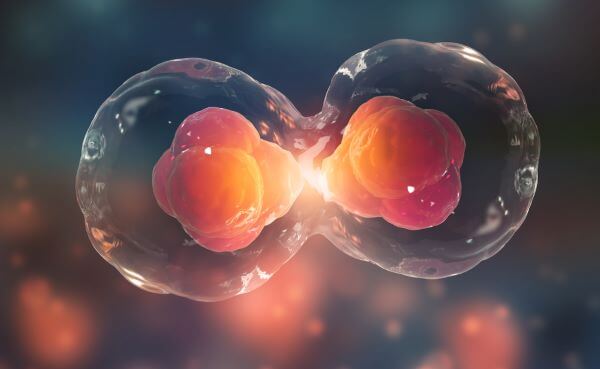
What are Mitosis and Meiosis?
Mitosis and meiosis are both types of cell division. Though there are similarities between mitosis and meiosis, there are some key differences between these two processes.
Mitosis is how new body cells are produced, whereas meiosis is used to produce gametes (i.e. sperm and egg cells).
Mitosis vs. Meiosis
Mitosis |
Meiosis |
| One cell division | Two cell divisions |
| Produces two daughter cells | Produces four daughter cells |
| Produces diploid cells | Produces haploid cells |
| Daughter cells are genetically identical | Daughter cells are non-identical |
| Produces body cells | Produces sex cells |
| No crossing-over occurs | Crossing-over occurs |
| Homologous chromosomes do not pair up | Homologous chromosomes do not pair up |
Mitosis
Mitosis is how the cells of your body reproduce. During mitosis, a diploid parent cell (i.e. a cell with two sets of chromosomes) makes a complete copy of its DNA before splitting in two. This process produces two genetically identical daughter cells and takes place across five phases.
The phases of mitosis are prophase, prometaphase, metaphase, anaphase, and telophase.
Before mitosis can begin, however, the cell must replicate its DNA. This happens during interphase, which happens over stages G1, S, and G2 of the cell cycle, and is not technically part of mitosis.
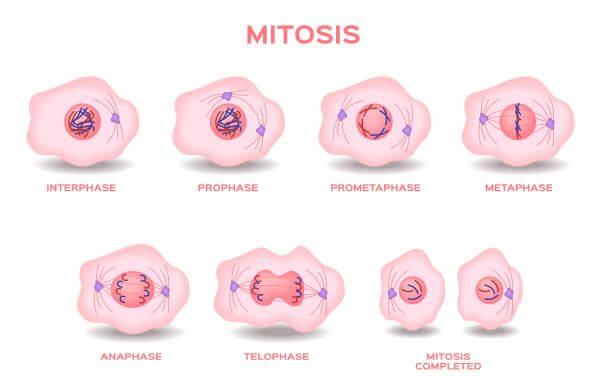
The Phases of Mitosis
Prophase
The first phase of mitosis is prophase. During prophase, the cell’s chromosomes condense and become visible under a light microscope. The nucleolus (the part of the nucleus where ribosomes are made) disappears, and the mitotic spindle (a cell structure made of microtubules) begins to form.
Prometaphase
The nuclear membrane breaks down. The microtubules attach themselves to the chromosomes and begin to move them around.
Metaphase
The microtubules move the chromosomes until they are lined up along the middle of the cell. This line of chromosomes is called the metaphase plate.
Anaphase
The chromosomes are pulled apart by the microtubules. Each chromosome is separated into two, genetically identical sister chromatids, which are pulled to opposite ends of the cell.
Telophase
The sister chromatids arrive at opposite ends of the cell. A new nuclear membrane begins to form around each set of chromosomes. The chromosomes decondense, so they are no longer visible under a light microscope. The nucleolus reappears, and the mitotic spindle disappears.
Finally, the cytoplasm of the cell splits, and two new, genetically identical daughter cells are formed. This process is called cytokinesis and usually takes place during telophase.
Meiosis
Almost all of your body’s cells divide by mitosis. Meiosis is used to produce only one type of cell, and those are the gametes. During meiosis, a diploid cell divides to produce four, non-identical haploid daughter cells, each containing a single set of chromosomes. In humans, these are sperm and egg cells.
Unlike mitosis, meiosis involves two rounds of cell division. These happen across two stages: Meiosis I, and Meiosis II. Each stage of meiosis can be further divided into five phases: prophase, prometaphase, metaphase, anaphase, and telophase.
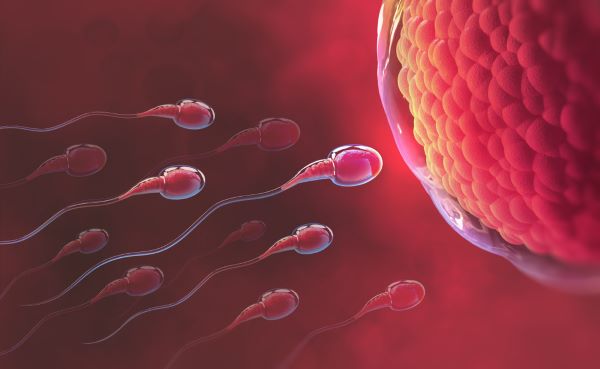
The Stages of Meiosis
Meiosis I
Like mitosis, meiosis I takes place across five stages. Before this first round of cell division begins, the cell’s DNA is replicated during the interphase of the cell cycle.
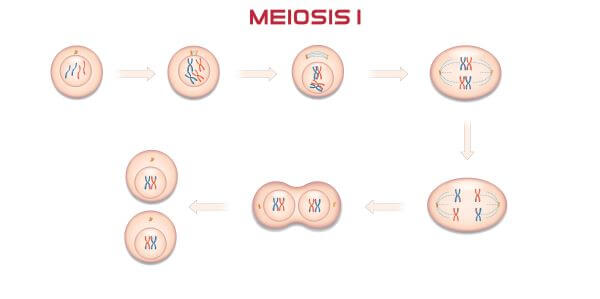
Prophase I
During prophase I, the chromosomes condense and form homologous pairs. Each homologous pair of chromosomes lines up carefully so their genes are aligned. Next, the chromosomes swap genetic material with one another, in a process known as crossing over. This ensures that each sister chromatid is no longer genetically identical.
Prometaphase I
During prometaphase I, the nuclear envelope breaks down and microtubules attach themselves to the chromosomes.
Metaphase I
The homologous chromosome pairs line up along the metaphase plate in the middle of the cell.
Anaphase I
The homologous pairs are separated by the microtubules and are pulled to opposite ends of the cell. The homologous pairs line up and are separated at random in a process known as independent segregation. This is done to further increase genetic diversity among daughter cells.
Telophase I
The chromosomes arrive at opposite ends of the cell, and the cytoplasm is split by cytokinesis.
The first round of cell division is complete. The two non-identical, haploid daughter cells now enter the second stage of meiosis.
Meiosis II
Meiosis II is very similar to the process of mitosis, except it involves two haploid cells rather than one diploid cell.
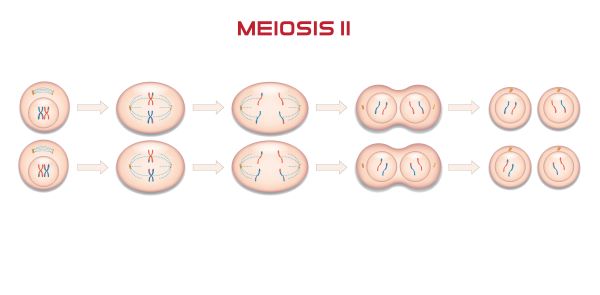
Prophase II
During prophase II, the chromosomes condense.
Prometaphase II
The nuclear envelopes are broken down and microtubules attach themselves to the chromosomes.
Metaphase II
The chromosomes line up along the metaphase plates.
Anaphase II
The chromosomes are pulled apart by microtubules. The non-identical sister chromatids are pulled to opposite ends of the cells.
Telophase II
The sister chromatids reach opposite ends of the cells. The cells are divided by cytokinesis, and four non-identical, haploid daughter cells are produced.
Mitosis vs. Meiosis: Differences and Similarities
Mitosis and meiosis are similar processes, but there are key differences between the two.
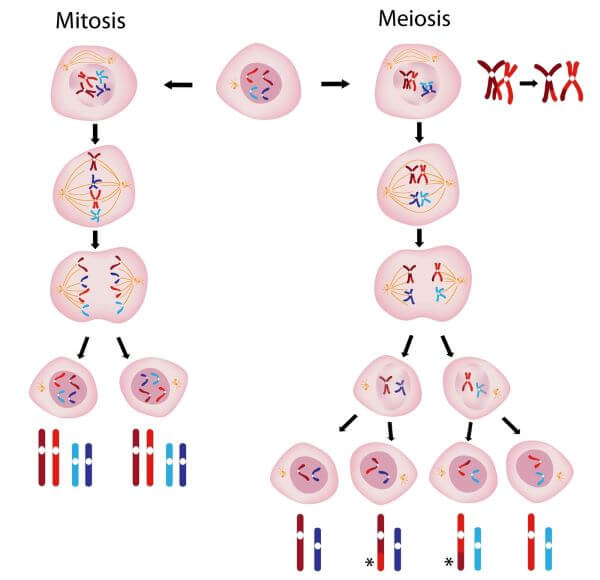
Products of Mitosis vs. Meiosis
Mitosis produces two genetically identical diploid cells, whereas meiosis produces four non-identical haploid cells.
Cell Types Involved in Mitosis vs. Meiosis
Mitosis involves the replication of somatic cells (i.e. any cells of the body that aren’t gametes), whereas meiosis is the process by which sperm and egg cells are produced.
Cell Division in Mitosis vs. Meiosis
Mitosis involves one round of cell division, whereas meiosis involves two.
Genetic Diversity in Mitosis vs. Meiosis
Mitosis produces genetically identical daughter cells, each containing a complete copy of the parent cell’s DNA. Meiosis produces four genetically non-identical daughter cells, which increases genetic variation among gametes (and, therefore, genetic diversity in the population).
